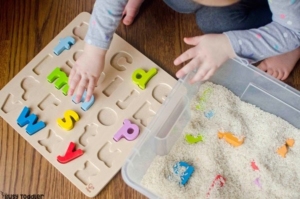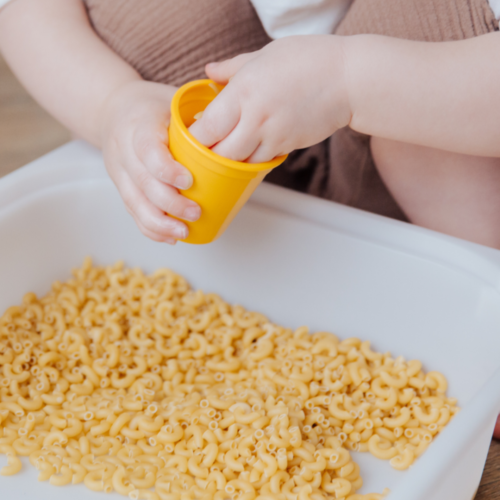Written By: Nicole Martens, MSOT, OTR/L
What is sensory input?
Sensory input is our ability to take in information from the external environment to our body through our sensory system to make connections and meaning of the world. Our sensory system is divided into 6 subcomponents: Gustatory (taste), Tactile (touch), Olfactory (smell), Auditory (hear), Vestibular (movement), Proprioceptive (position in space), and Interoception (internal sense).
What is the purpose of a sensory bin?
Sensory bins offer children the opportunity to explore the world through play and activate their senses to learn and grow and from their environment.
Sensory bins support:
• Cognitive development
• Fine motor skill development
• Visual motor skill development
• Bilateral coordination
• Seated attention
• Language development
• Feeding exploration
• Play skill development
• Motor planning skill
• Social skills
How can I make sensory bins functional?
1. Exploration: Allowing exploration of a novel texture offers children an opportunity to develop a safe and comfortable relationship with the new sensations they experience from the texture. Allow time for your child to process what the texture offers to their sensory system.
2. Description: Talk to your child about how the textures feels, smells, and even tastes (if edible). Is this soft or hard? Is this wet or dry? Is this warm or cold? This gives opportunities to sense the world and also expand language.
3. Imitation: Your child is always watching what you do. Show different ways to engage with the texture by bringing in tools, animals, shapes, or puzzle pieces. You can demonstrate scooping, dumping, digging, stirring, squeezing, or hiding. Don’t forget to use language here, too!
4. Expansion: Capture the child’s attention in their pattern of play and show a new way of engaging with the bin texture. For example, if your child enjoys scooping and dumping sand, show them to scoop and dump sand within a bucket or mold. Offer a demonstration of how to pat sand within the container to make a molded shape (like a sand castle). Bringing your children’s hand into these motor patterns allows them to learn new ways to use their hands, too!
What materials can I use?
• Loose wet goods including: Water (plain or with food coloring), Ice cubes (plain or with food coloring), Smoothies
• Semi-wet goods including: Wet soil, Wet sand, Snow, Shaving cream, Whipped cream, Smoothies/Shakes, Yogurt, Pumpkin guts, Applesauce, Condiments, Pudding, Jell-o, Moon sand, Cornstarch and water (Ooblick), Water beads, Playdoh
• Dry natural goods including: Rice, Pasta, Quinoa, Cream of Wheat, Coffee Beans, Coffee grounds, Dry sand, Dry soil, Cornmeal, Oatmeal, Leaves, Flowers, Cotton balls, Poms, Cardboard, Tissue paper shreds, Bubble wrap
Ms. Nicole’s Favorite Sensory Bin 
Photo: https://busytoddler.com/puzzle-hunt-sensory-bin/
Hiding puzzle pieces into sensory bins is my favorite activity because puzzles can become very boring! Children love an opportunity to dig into textures to find puzzle letters, numbers, animals, or shapes. This helps them develop in so many areas, but to name a few: fine motor skill, visual motor skill, expressive/receptive language skill, identification and matching of objects, imitation in play, problem solving, cause and effect play, and following multi-step directions in play.

